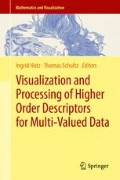Abstract
Production of electricity and propulsion systems involve turbulent combustion. Computational modeling of turbulent combustion can improve the efficiency of these processes. However, large tensor datasets are the result of such simulations; these datasets are difficult to visualize and analyze. In this work we present an unsupervised statistical approach for the segmentation, visualization and potentially the tracking of regions of interest in large tensor data. The approach employs a machine learning clustering algorithm to locate and identify areas of interest based on specified parameters such as strain tensor value. Evaluation on two combustion datasets shows this approach can assist in the visual analysis of the combustion tensor field.
Access this chapter
Tax calculation will be finalised at checkout
Purchases are for personal use only
References
Anderson, J.D.J.: Modern Compressible Flow: With Historical Perspective, 3rd edn. McGraw-Hill Science/Engineering/Math (2002)
Caban, J.J., Joshi, A., Rheingans, P.: Texture-based feature tracking for effective time-varying data visualization. IEEE Trans. Vis. Comput. Graph. 13(6), 1472–1479 (2007)
Elmqvist, N., Stasko, J., Tsigas, P.: Datameadow: a visual canvas for analysis of large-scale multivariate data. In: VAST IEEE Symposium on Visual Analytics Science and Technology, Proceedings, pp. 187–194 (2007)
Inselberg, A., Dimsdale, B.: Parallel coordinates: a tool for visualizing multi-dimensional geometry. In: Proceedings of the 1st Conference on Visualization ’90 (VIS ’90), San Francisco, pp. 361–378. IEEE Computer Society Press, Los Alamitos (1990). http://dl.acm.org/citation.cfm?id=949531.949588
Ji, G., Shen, H.-W., Wenger, R.: Volume tracking using higher dimensional isosurfacing. In: Proceedings of the 14th IEEE Visualization, pp. 209–216 (2003)
Klippel, A., Hardisty, F., Li, R., Weaver, C.: Colour-enhanced star plot glyphs: can salient shape characteristics be overcome? Cartogr.: Int. J. Geogr. Inf. Geovis. 44(3), 217–231 (2009)
Lovely, D., Haimesy, R.: Shock detection from computational fluid dynamics results. In: Proceedings of the 14th AIAA Computational Fluid Dynamics Conference, 1:M2 (1999)
Ma, K.-L., Rosendale, J.V., Vermeer, W.: 3d shock wave visualization on unstructured grids. In: IEEE Symposium on Volume Visualization and Graphics, pp. 87–104 (1996)
Maries, A., Haque, M., Yilmaz, S., Nik, M., Marai, G.: Interactive exploration of stress tensors used in computational turbulent combustion. In: Laidlaw, D., Villanova, A. (eds.) New Developments in the Visualization and Processing of Tensor Fields, pp. 137–156. Springer, Heidelberg (2012)
McCallum, A., Nigam, K., Ungar, L.H.: Efficient clustering of high-dimensional data sets with application to reference matching. In: Proceedings of the Sixth ACM SIGKDD International Conference on Knowledge Discovery and Data Mining, KDD ’00, pp. 169–178. ACM Press, New York (2000)
Meyer, F., Bouthemy, P.: Region-based tracking using affine motion models in long image sequences. CVGIP: Image Underst. 60(2), 119–140 (1994)
Muelder, C., Ma, K.-L.: Interactive feature extraction and tracking by utilizing region coherency. In: IEEE Pacific Visualization Symposium, PacificVis ’09, pp. 17–24 (2009)
Ozer, S., Wei, J., Silver, D., Ma, K.-L., Martin, P.: Group dynamics in scientific visualization. In: IEEE Symposium on Large Data Analysis and Visualization (LDAV), pp. 97–104 (2012)
Pagendarm, H.-G., Seitz, B.: An algorithm for detection and visualization of discontinuities in scientific data fields applied to flow data with shock waves. In: Scientific Visualization: Advanced Software Techniques, pp. 161–177 (1993)
Post, F.H., Vrolijk, B., Hauser, H., Larameeand, R.S., Doleisch, H.: The state of the art in flow visualisation: feature extraction and tracking. Comput. Graphics Forum 22(4), 775–792 (2003)
Samtaney, R., Silver, D., Zabusky, N., Cao, J.: Visualizing features and tracking their evolution. Computer 27(7), 20–27 (1994)
Silver, D., Wang, X.: Volume tracking. In: Proceedings of Seventh Annual IEEE Visualization ’96, pp. 157–164 (1996)
Silver, D., Wang, X.: Tracking and visualizing turbulent 3d features. IEEE Trans. Vis. Comput. Graph. 3(2), 129–141 (1997)
Smith, S.M., Brady, J.M.: Asset-2: real-time motion segmentation and shape tracking. IEEE Trans. Pattern Anal. Mach. Intell. 17(8), 814–820 (1995)
Tzeng, F.-Y., Ma, K.-L.: Intelligent feature extraction and tracking for visualizing large-scale 4d flow simulations. In: Proceedings of the ACM/IEEE SC 2005 Conference Supercomputing, p. 6 (2005)
Wegman, E.J.: Hyperdimensional data analysis using parallel coordinates. J. Am. Stat. Assoc. 85(411), 664–675 (1990)
Acknowledgements
This work was supported by NSF CBET-1250171 and NSF CAREER IIS-0952720.
Author information
Authors and Affiliations
Corresponding author
Editor information
Editors and Affiliations
Rights and permissions
Copyright information
© 2015 Springer International Publishing Switzerland
About this paper
Cite this paper
Maries, A. et al. (2015). A Clustering Method for Identifying Regions of Interest in Turbulent Combustion Tensor Fields. In: Hotz, I., Schultz, T. (eds) Visualization and Processing of Higher Order Descriptors for Multi-Valued Data. Mathematics and Visualization. Springer, Cham. https://doi.org/10.1007/978-3-319-15090-1_16
Download citation
DOI: https://doi.org/10.1007/978-3-319-15090-1_16
Publisher Name: Springer, Cham
Print ISBN: 978-3-319-15089-5
Online ISBN: 978-3-319-15090-1
eBook Packages: Mathematics and StatisticsMathematics and Statistics (R0)

